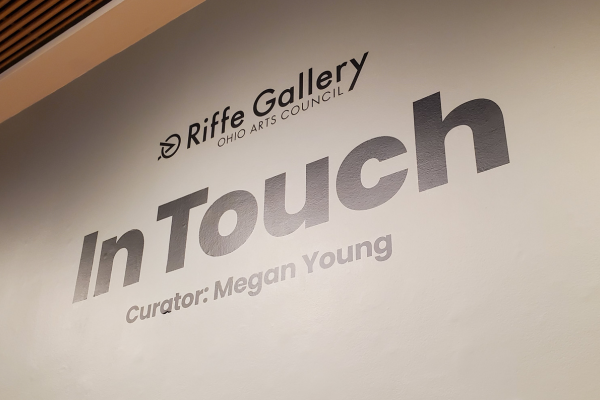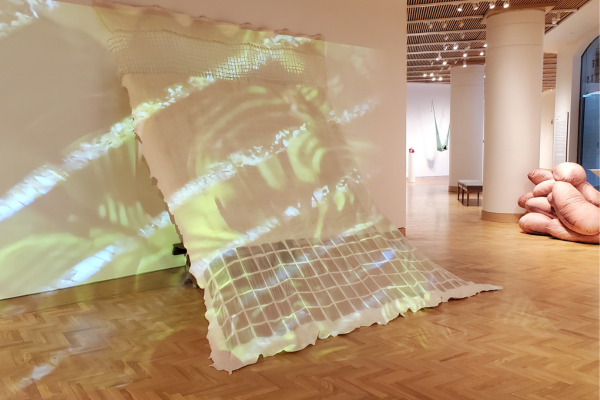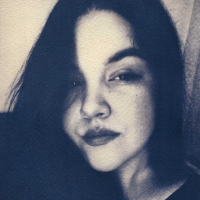Ekphrasis: Writing as a Tool for Collective Art Experiences at Riffe Gallery

Sitting across from the Ohio Statehouse, the Ohio Art Council’s Riffe Gallery displays a diverse range of work by Ohio-based artists that visitors can enjoy for free. The Riffe’s current exhibition, In Touch, is focused on physical and interpersonal connection through the lens of reconnecting to the world and each other in a post-pandemic world. The work in the exhibition explores sensory experiences and different approaches to embodiment.
The Riffe Gallery space served as the inspiration for a writing workshop led by Amy Turn Sharp, a local poet and the owner of Secret Studio, a creative space and art gallery located in Franklinton. Amy’s workshop was open to writers of all backgrounds and experience levels, who were able to contribute both in person and via video chat. She emphasized that we should mainly use the artworks and our own feelings as a guide while writing short pieces and fragments. Through this, we honored our own thought processes by trying not to censor or edit ourselves, with the idea that the stream-of-consciousness approach would allow us to connect with the art organically and could inspire more creative writing after the workshop. She also ensured that the workshop was a safe place for participants to share their responses as well as appreciate other’s contributions.

My relationship to writing has been turbulent. With my main experiences being essay writing in school, I have often dreaded having to write anything and get my thoughts down on a page. However, the creative side of me has long admired those who are able to craft clever narratives or poetically put emotions into words. It was only recently, with academic writing far behind me, that I have started to share writing with loved ones through letters or creative prose.
Thankfully, writing about art has been one experience with writing that I truly enjoyed. In previous art history courses, the focus was on analyzing artworks, where the goal was to articulate what I saw while recognizing the artist's intentions. When immersing oneself in an artwork, truly seeing and acknowledging the many factors that make up the entire picture, it is easy to form personal connections. Although description and analysis came easily to me, at times it was limiting to avoid expressing personal feelings about the piece. I’ve found after repeatedly studying a painting, the subjects and brushstrokes become as familiar as an old friend. Subsequently, encountering the artwork again or discovering another creation by the same artist brought a feeling of understanding.

Amy’s workshop was framed around ekphrastic writing, which is an immersive practice in which a writer draws inspiration from an artwork as a foundation for their piece. This prose or poetry is often imaginative and evocative, as the writer draws emotions from the piece and provides their own interpretation of the meaning. In the case of the workshop, we used the works in the In Touch exhibition as the foundation for our ekphrasis. This was my first exploration of this kind of writing exercise, and I thoroughly valued it as a way of interacting with art, especially within a gallery setting.
The act of viewing art can be inherently voyeuristic, as the audience delves into the artist's portrayal of an intimate subject matter or private moment. Ekphrasis offers writers an opportunity to empathize with both the subject and the artist. Unlike analytical approaches that declare, "I see you, I know you," ekphrasis says “I feel you.” By writing from the point of view of the subject, or drawing inspiration from the setting, writers enable both themselves—and eventually the reader—to delve deeper into the artwork's meaning through their own perceptions.
In My Hotel Window/Card Game by photographer Pipo Nguyen-duy, the almost-glowing red curtains serve as a frame for the viewer to gaze upon the people who are engaged in a card game on the street below. The elevated perspective and partial shroud of the curtains further separate the viewer from the subjects below. Yet simultaneously, the scene serves as an expression of the ways in which humans share space, and at times we have all either been looking through a window or witnessed in our daily life.

In the workshop, Amy asked us to spend time with the photograph and write for ten minutes from the point of view of the person reacting to what they see through the window and how they feel in that moment. We also wrote for an additional ten minutes from the point of view of the people playing cards, about how they could feel about being watched and about what brought them to this moment. It was interesting to hear the different reactions my fellow workshop-writers had to this photograph, and the various directions they took their narratives and the manifestations for their subjects.
Engaging with and creating art is significantly influenced by one's lived experiences. Every viewer brings their unique background and knowledge of the world, shaping their responses to a piece of art. An advantage of using ekphrastic writing as a means of engagement lies in its ability to enable writers to deeply engage with the artwork, inviting a connection through personal experiences and emotions, or prompting writers to envision scenarios outside what they are familiar with. Along with conversation, analysis, and other methods of engagement, immersive art practices allow the viewer, writer, and artist to transcend individual perspectives and intertwine their stories with a broader collective experience. In doing so, they highlight art's potential to both reflect complex human experiences and foster a more interconnected, understanding community.
Amy Turn Sharp can be found at Secret Studio in Franklinton and on her Instagram. In Touch is on view at the Riffe Gallery in downtown Columbus until April 5.


